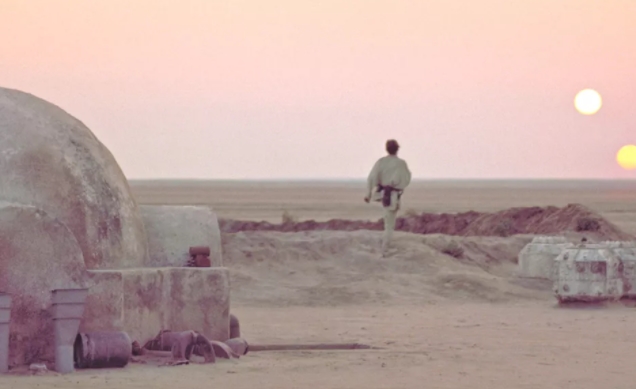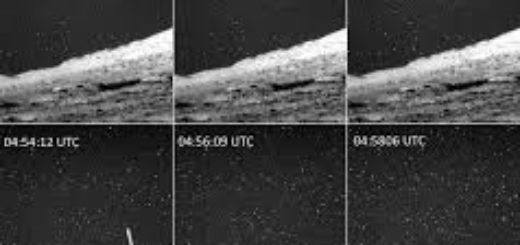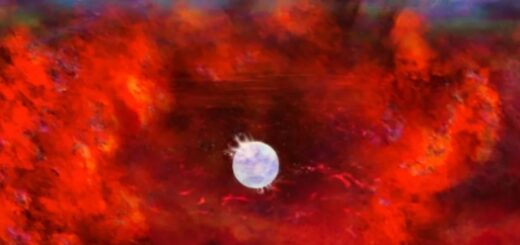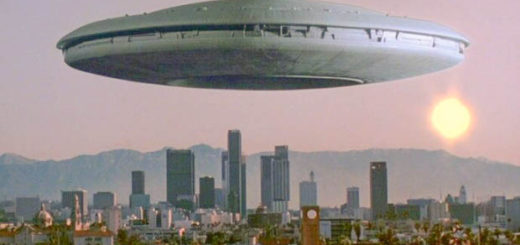Researchers identify systems that could have Tatooine-like planets with twin suns

Luke Skywalker takes in Tatooine’s twin sunset in the original Star Wars. Scientists reckon such habitable planets might orbit multiple suns in real life.
LucasFilm
Desert planet Tatooine isn’t the most inviting world in the Star Wars galaxy, but its twin suns offer a visually stunning end to each day and keep inhabitants warm. It also seemed firmly rooted in the realm of science fiction, but scientists have found evidence that habitable worlds with multiple stars might exist. On Thursday, they published their study in Frontiers in Astronomy and Space Sciences.
Researchers at New York University Abu Dhabi and the University of Washington developed a mathematical framework showing that five known systems with multiple stars — Kepler-34, -35, -38, -64 and -413 — are possible candidates for supporting life. They lie between 2764 and 5933 light-years (one light-year is about 6 trillion miles) from Earth, in the constellations Lyra and Cygnus.
These systems — which were detected by NASA’s since-retired Kepler space telescope — support a permanent “habitable zone,” a region around stars in which liquid water could persist on undiscovered Earth-like planets. All of them have at least one giant planet the size of Neptune or greater, and Kepler-64 has at least four stars orbiting one another at its center, while the other systems have two stars.
“Life is far most likely to evolve on planets located within their system’s habitable zone, just like Earth. Here we investigate whether a habitable zone exists within nine known systems with two or more stars orbited by giant planets,” co-author Nikolaos Georgakarakos said in a release. “We show for the first time that Kepler-34, -35, -64, -413 and especially Kepler-38 are suitable for hosting Earth-like worlds with oceans.”
Binary systems — those with a close pair of stars — are estimated to represent between half and three-quarters of all star systems, and only giant planets have been discovered in them so far. However, the researchers suspect smaller Earth-like planets and moons have escaped detection.
“We’ve known for a while that binary star systems without giant planets have the potential to harbor habitable worlds. What we have shown here is that in a large fraction of those systems Earth-like planets can remain habitable even in the presence of giant planets,” co-author Ian Dobbs-Dixon noted in the release.
Their framework looks at the class, mass, luminosity and spectral energy distribution of the stars. It also factors in the giant planets’ gravitational effect and examines a hypothetical Earth-like planet’s orbit and the impact of radiation. From there, they determine if a habitable zone exists and is “quiet enough” to harbor potentially life-sustaining worlds.
“Our best candidate for hosting a world that is potentially habitable is the binary system Kepler-38, approximately 3970 light years from Earth, and known to contain a Neptune-sized planet,” Georgakarakos noted. “Our study confirms that even binary star systems with giant planets are hot targets in the search for Earth 2.0. Watch out Tatooine, we are coming.”



 Creators of mankind
Creators of mankind Description of “Tall white aliens”
Description of “Tall white aliens” Where they came from?
Where they came from? About hostile civilizations
About hostile civilizations The war for the Earth
The war for the Earth “Tall white aliens” about eternal life
“Tall white aliens” about eternal life Video: “Nordic aliens”
Video: “Nordic aliens” Aliens
Aliens Alien encounters
Alien encounters The aliens base
The aliens base UFO
UFO Technology UFO
Technology UFO Underground civilization
Underground civilization Ancient alien artifacts
Ancient alien artifacts Military and UFO
Military and UFO Mysteries and hypotheses
Mysteries and hypotheses Scientific facts
Scientific facts


















